PUBH2000: Comprehensive Analysis of the Canadian Healthcare System
VerifiedAdded on 2023/06/11
|11
|2336
|453
Report
AI Summary
This report provides a comprehensive analysis of the Canadian Healthcare System (CHS), evaluating its performance based on key indicators, the role of government, healthcare funding mechanisms, and the healthcare workforce. It compares the Canadian system with that of Australia, highlighting differences in governance, funding decentralization, and workforce size. The report delves into health system performance indicators such as effectiveness, accessibility, safety, and efficiency, referencing studies that assess Canada's healthcare system against these metrics. It also outlines the roles of federal, provincial, and territorial governments in healthcare delivery and funding, emphasizing the principles of the Canada Health Act. The analysis of healthcare funding covers federal contributions, provincial coverage, and per capita spending, noting the significant growth in healthcare expenditure relative to overall economic growth. Finally, the report examines the healthcare workforce, comparing the number of doctors per capita in Canada with other countries and detailing the distribution of healthcare personnel within Canada. The report concludes that while Australia has a more decentralized system and a larger healthcare workforce, Canada offers more complete coverage of healthcare expenses.
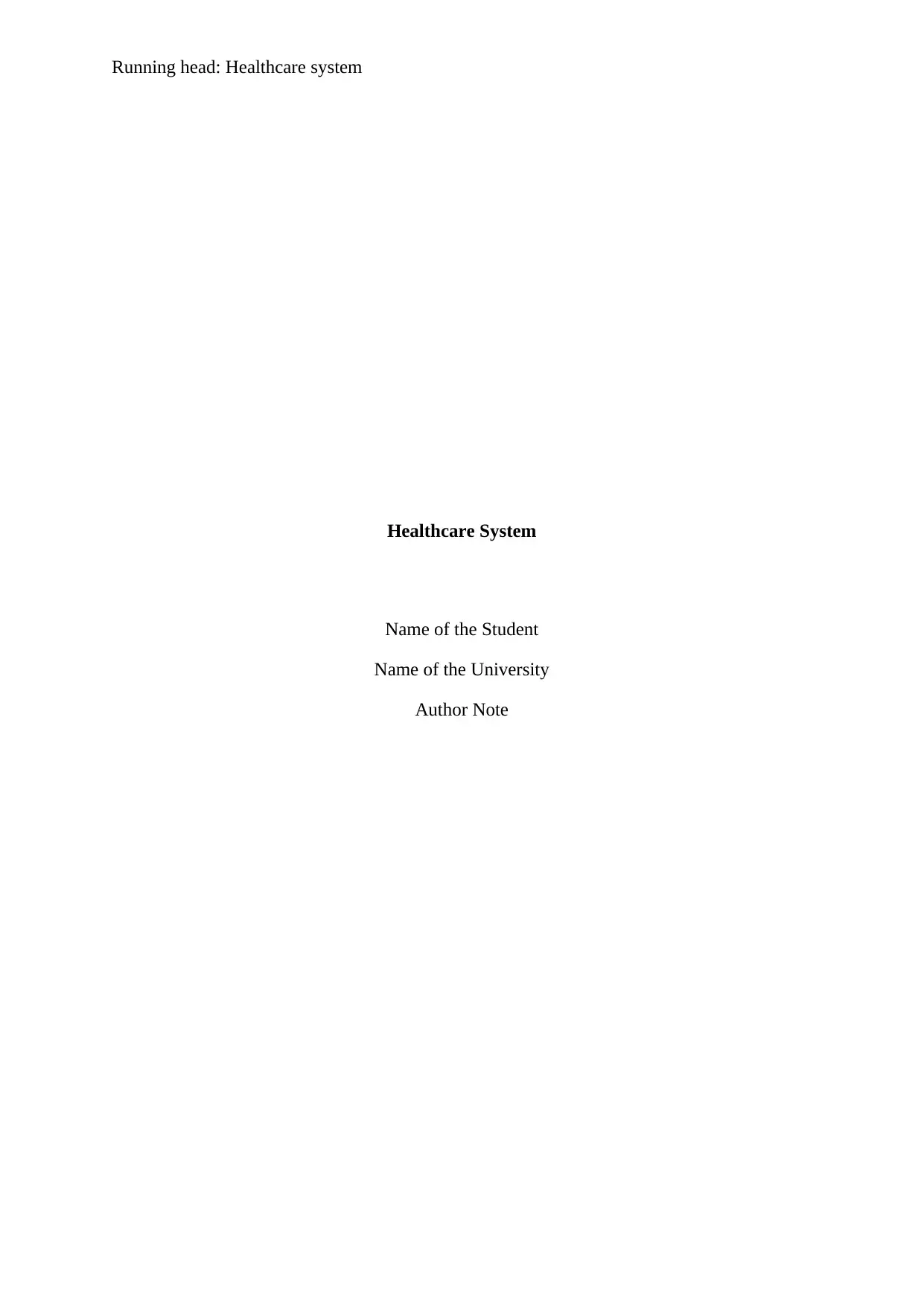
Running head: Healthcare system
Healthcare System
Name of the Student
Name of the University
Author Note
Healthcare System
Name of the Student
Name of the University
Author Note
Paraphrase This Document
Need a fresh take? Get an instant paraphrase of this document with our AI Paraphraser
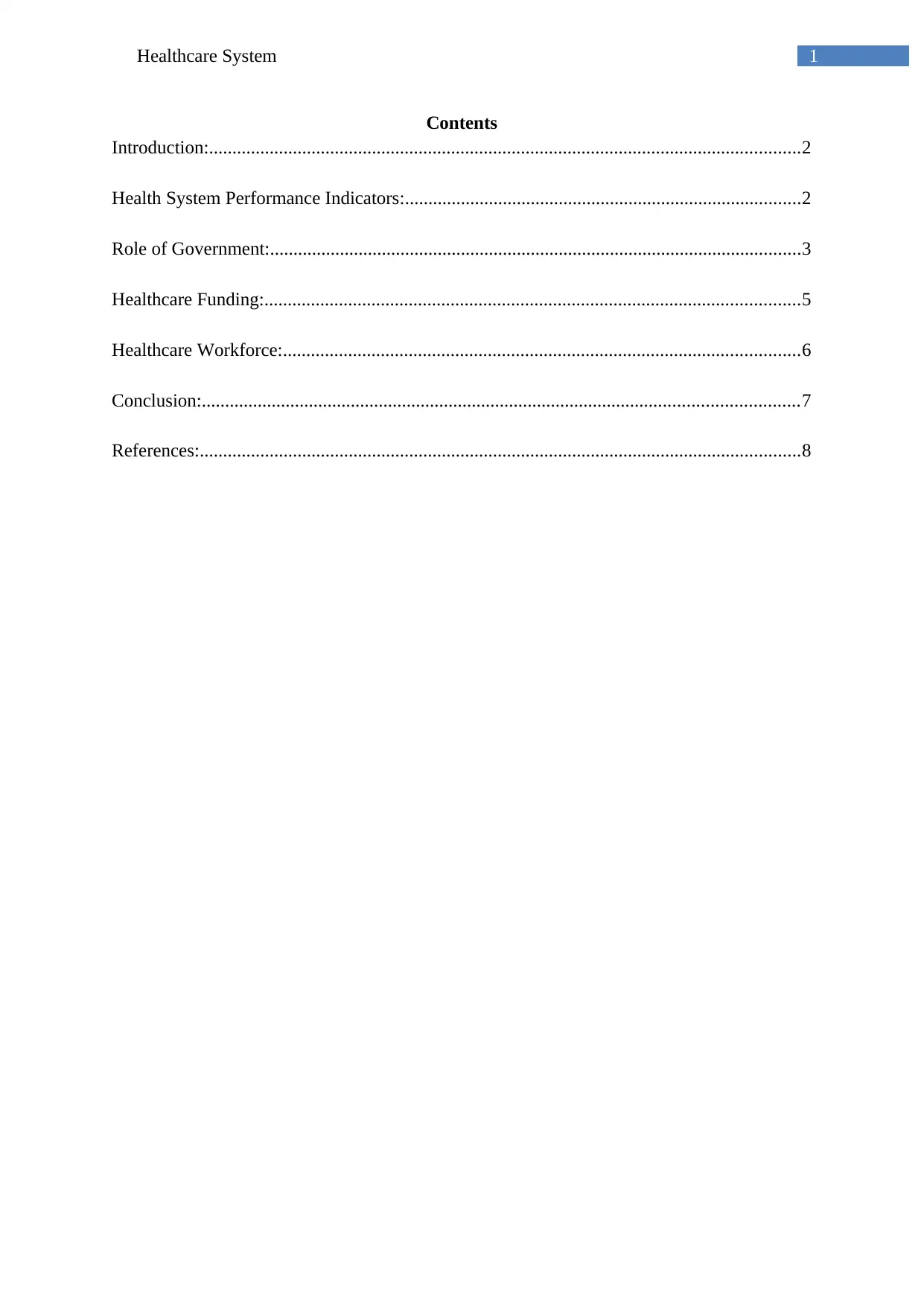
1Healthcare System
Contents
Introduction:...............................................................................................................................2
Health System Performance Indicators:.....................................................................................2
Role of Government:..................................................................................................................3
Healthcare Funding:...................................................................................................................5
Healthcare Workforce:...............................................................................................................6
Conclusion:................................................................................................................................7
References:.................................................................................................................................8
Contents
Introduction:...............................................................................................................................2
Health System Performance Indicators:.....................................................................................2
Role of Government:..................................................................................................................3
Healthcare Funding:...................................................................................................................5
Healthcare Workforce:...............................................................................................................6
Conclusion:................................................................................................................................7
References:.................................................................................................................................8
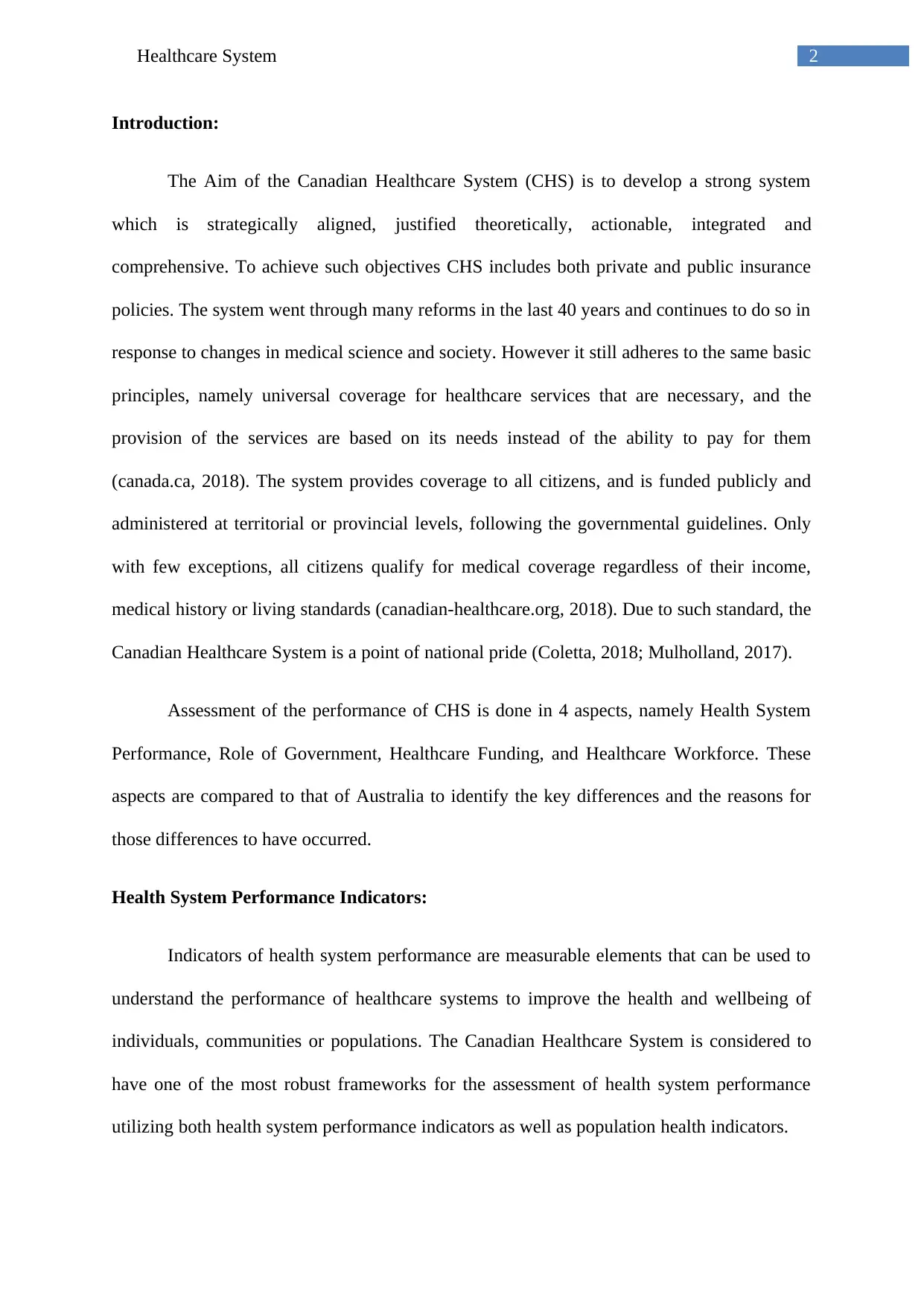
2Healthcare System
Introduction:
The Aim of the Canadian Healthcare System (CHS) is to develop a strong system
which is strategically aligned, justified theoretically, actionable, integrated and
comprehensive. To achieve such objectives CHS includes both private and public insurance
policies. The system went through many reforms in the last 40 years and continues to do so in
response to changes in medical science and society. However it still adheres to the same basic
principles, namely universal coverage for healthcare services that are necessary, and the
provision of the services are based on its needs instead of the ability to pay for them
(canada.ca, 2018). The system provides coverage to all citizens, and is funded publicly and
administered at territorial or provincial levels, following the governmental guidelines. Only
with few exceptions, all citizens qualify for medical coverage regardless of their income,
medical history or living standards (canadian-healthcare.org, 2018). Due to such standard, the
Canadian Healthcare System is a point of national pride (Coletta, 2018; Mulholland, 2017).
Assessment of the performance of CHS is done in 4 aspects, namely Health System
Performance, Role of Government, Healthcare Funding, and Healthcare Workforce. These
aspects are compared to that of Australia to identify the key differences and the reasons for
those differences to have occurred.
Health System Performance Indicators:
Indicators of health system performance are measurable elements that can be used to
understand the performance of healthcare systems to improve the health and wellbeing of
individuals, communities or populations. The Canadian Healthcare System is considered to
have one of the most robust frameworks for the assessment of health system performance
utilizing both health system performance indicators as well as population health indicators.
Introduction:
The Aim of the Canadian Healthcare System (CHS) is to develop a strong system
which is strategically aligned, justified theoretically, actionable, integrated and
comprehensive. To achieve such objectives CHS includes both private and public insurance
policies. The system went through many reforms in the last 40 years and continues to do so in
response to changes in medical science and society. However it still adheres to the same basic
principles, namely universal coverage for healthcare services that are necessary, and the
provision of the services are based on its needs instead of the ability to pay for them
(canada.ca, 2018). The system provides coverage to all citizens, and is funded publicly and
administered at territorial or provincial levels, following the governmental guidelines. Only
with few exceptions, all citizens qualify for medical coverage regardless of their income,
medical history or living standards (canadian-healthcare.org, 2018). Due to such standard, the
Canadian Healthcare System is a point of national pride (Coletta, 2018; Mulholland, 2017).
Assessment of the performance of CHS is done in 4 aspects, namely Health System
Performance, Role of Government, Healthcare Funding, and Healthcare Workforce. These
aspects are compared to that of Australia to identify the key differences and the reasons for
those differences to have occurred.
Health System Performance Indicators:
Indicators of health system performance are measurable elements that can be used to
understand the performance of healthcare systems to improve the health and wellbeing of
individuals, communities or populations. The Canadian Healthcare System is considered to
have one of the most robust frameworks for the assessment of health system performance
utilizing both health system performance indicators as well as population health indicators.
⊘ This is a preview!⊘
Do you want full access?
Subscribe today to unlock all pages.

Trusted by 1+ million students worldwide
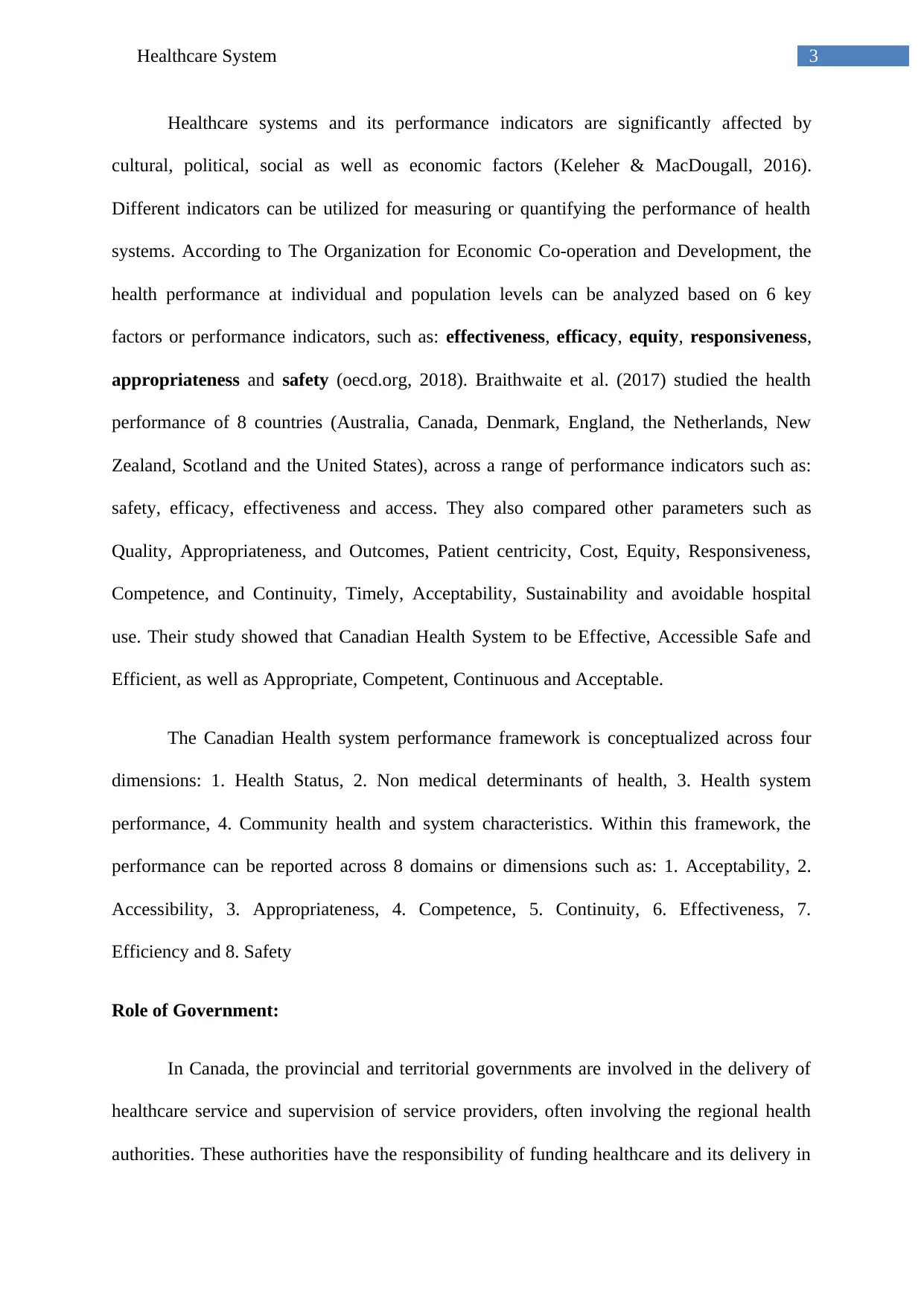
3Healthcare System
Healthcare systems and its performance indicators are significantly affected by
cultural, political, social as well as economic factors (Keleher & MacDougall, 2016).
Different indicators can be utilized for measuring or quantifying the performance of health
systems. According to The Organization for Economic Co-operation and Development, the
health performance at individual and population levels can be analyzed based on 6 key
factors or performance indicators, such as: effectiveness, efficacy, equity, responsiveness,
appropriateness and safety (oecd.org, 2018). Braithwaite et al. (2017) studied the health
performance of 8 countries (Australia, Canada, Denmark, England, the Netherlands, New
Zealand, Scotland and the United States), across a range of performance indicators such as:
safety, efficacy, effectiveness and access. They also compared other parameters such as
Quality, Appropriateness, and Outcomes, Patient centricity, Cost, Equity, Responsiveness,
Competence, and Continuity, Timely, Acceptability, Sustainability and avoidable hospital
use. Their study showed that Canadian Health System to be Effective, Accessible Safe and
Efficient, as well as Appropriate, Competent, Continuous and Acceptable.
The Canadian Health system performance framework is conceptualized across four
dimensions: 1. Health Status, 2. Non medical determinants of health, 3. Health system
performance, 4. Community health and system characteristics. Within this framework, the
performance can be reported across 8 domains or dimensions such as: 1. Acceptability, 2.
Accessibility, 3. Appropriateness, 4. Competence, 5. Continuity, 6. Effectiveness, 7.
Efficiency and 8. Safety
Role of Government:
In Canada, the provincial and territorial governments are involved in the delivery of
healthcare service and supervision of service providers, often involving the regional health
authorities. These authorities have the responsibility of funding healthcare and its delivery in
Healthcare systems and its performance indicators are significantly affected by
cultural, political, social as well as economic factors (Keleher & MacDougall, 2016).
Different indicators can be utilized for measuring or quantifying the performance of health
systems. According to The Organization for Economic Co-operation and Development, the
health performance at individual and population levels can be analyzed based on 6 key
factors or performance indicators, such as: effectiveness, efficacy, equity, responsiveness,
appropriateness and safety (oecd.org, 2018). Braithwaite et al. (2017) studied the health
performance of 8 countries (Australia, Canada, Denmark, England, the Netherlands, New
Zealand, Scotland and the United States), across a range of performance indicators such as:
safety, efficacy, effectiveness and access. They also compared other parameters such as
Quality, Appropriateness, and Outcomes, Patient centricity, Cost, Equity, Responsiveness,
Competence, and Continuity, Timely, Acceptability, Sustainability and avoidable hospital
use. Their study showed that Canadian Health System to be Effective, Accessible Safe and
Efficient, as well as Appropriate, Competent, Continuous and Acceptable.
The Canadian Health system performance framework is conceptualized across four
dimensions: 1. Health Status, 2. Non medical determinants of health, 3. Health system
performance, 4. Community health and system characteristics. Within this framework, the
performance can be reported across 8 domains or dimensions such as: 1. Acceptability, 2.
Accessibility, 3. Appropriateness, 4. Competence, 5. Continuity, 6. Effectiveness, 7.
Efficiency and 8. Safety
Role of Government:
In Canada, the provincial and territorial governments are involved in the delivery of
healthcare service and supervision of service providers, often involving the regional health
authorities. These authorities have the responsibility of funding healthcare and its delivery in
Paraphrase This Document
Need a fresh take? Get an instant paraphrase of this document with our AI Paraphraser
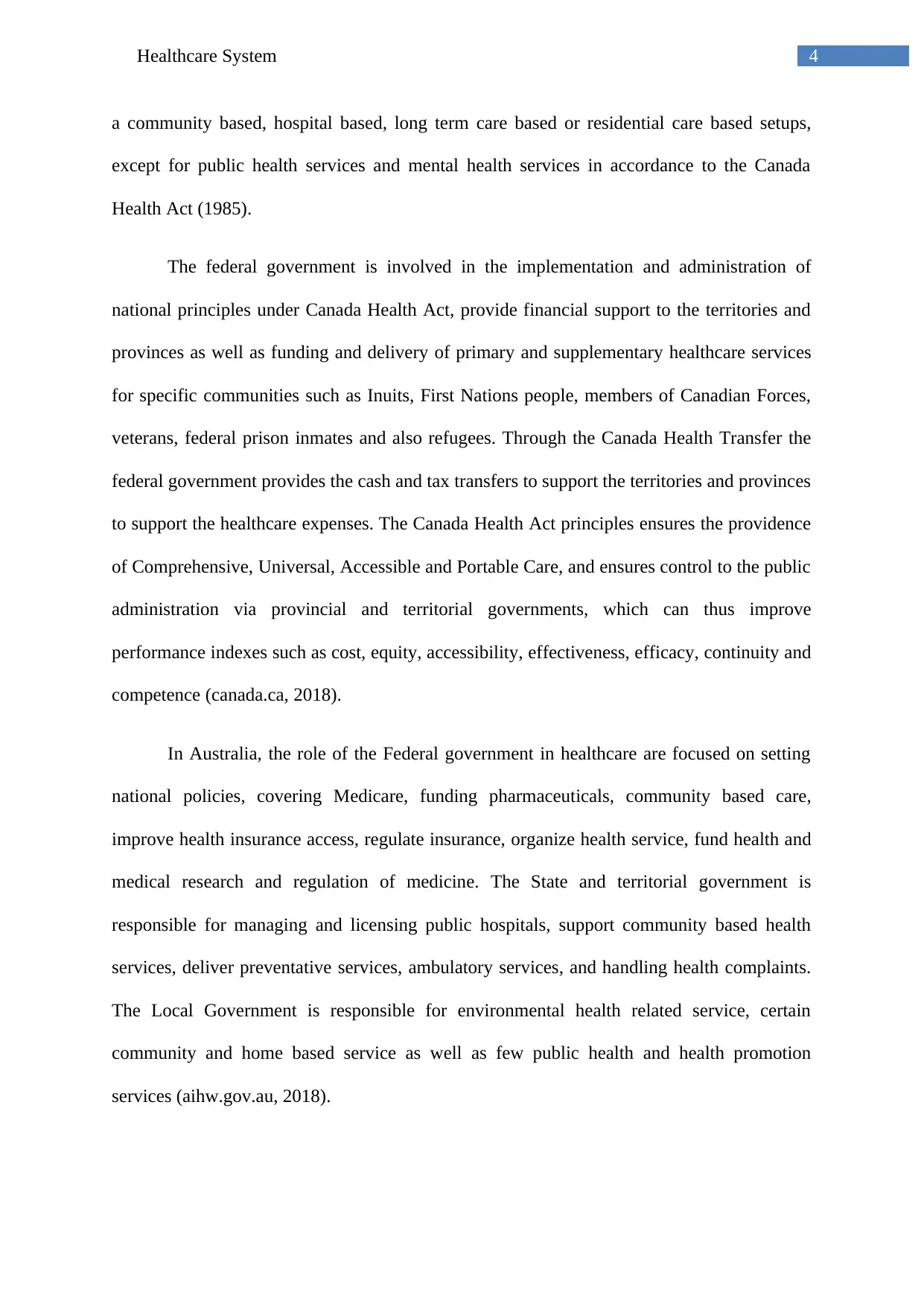
4Healthcare System
a community based, hospital based, long term care based or residential care based setups,
except for public health services and mental health services in accordance to the Canada
Health Act (1985).
The federal government is involved in the implementation and administration of
national principles under Canada Health Act, provide financial support to the territories and
provinces as well as funding and delivery of primary and supplementary healthcare services
for specific communities such as Inuits, First Nations people, members of Canadian Forces,
veterans, federal prison inmates and also refugees. Through the Canada Health Transfer the
federal government provides the cash and tax transfers to support the territories and provinces
to support the healthcare expenses. The Canada Health Act principles ensures the providence
of Comprehensive, Universal, Accessible and Portable Care, and ensures control to the public
administration via provincial and territorial governments, which can thus improve
performance indexes such as cost, equity, accessibility, effectiveness, efficacy, continuity and
competence (canada.ca, 2018).
In Australia, the role of the Federal government in healthcare are focused on setting
national policies, covering Medicare, funding pharmaceuticals, community based care,
improve health insurance access, regulate insurance, organize health service, fund health and
medical research and regulation of medicine. The State and territorial government is
responsible for managing and licensing public hospitals, support community based health
services, deliver preventative services, ambulatory services, and handling health complaints.
The Local Government is responsible for environmental health related service, certain
community and home based service as well as few public health and health promotion
services (aihw.gov.au, 2018).
a community based, hospital based, long term care based or residential care based setups,
except for public health services and mental health services in accordance to the Canada
Health Act (1985).
The federal government is involved in the implementation and administration of
national principles under Canada Health Act, provide financial support to the territories and
provinces as well as funding and delivery of primary and supplementary healthcare services
for specific communities such as Inuits, First Nations people, members of Canadian Forces,
veterans, federal prison inmates and also refugees. Through the Canada Health Transfer the
federal government provides the cash and tax transfers to support the territories and provinces
to support the healthcare expenses. The Canada Health Act principles ensures the providence
of Comprehensive, Universal, Accessible and Portable Care, and ensures control to the public
administration via provincial and territorial governments, which can thus improve
performance indexes such as cost, equity, accessibility, effectiveness, efficacy, continuity and
competence (canada.ca, 2018).
In Australia, the role of the Federal government in healthcare are focused on setting
national policies, covering Medicare, funding pharmaceuticals, community based care,
improve health insurance access, regulate insurance, organize health service, fund health and
medical research and regulation of medicine. The State and territorial government is
responsible for managing and licensing public hospitals, support community based health
services, deliver preventative services, ambulatory services, and handling health complaints.
The Local Government is responsible for environmental health related service, certain
community and home based service as well as few public health and health promotion
services (aihw.gov.au, 2018).
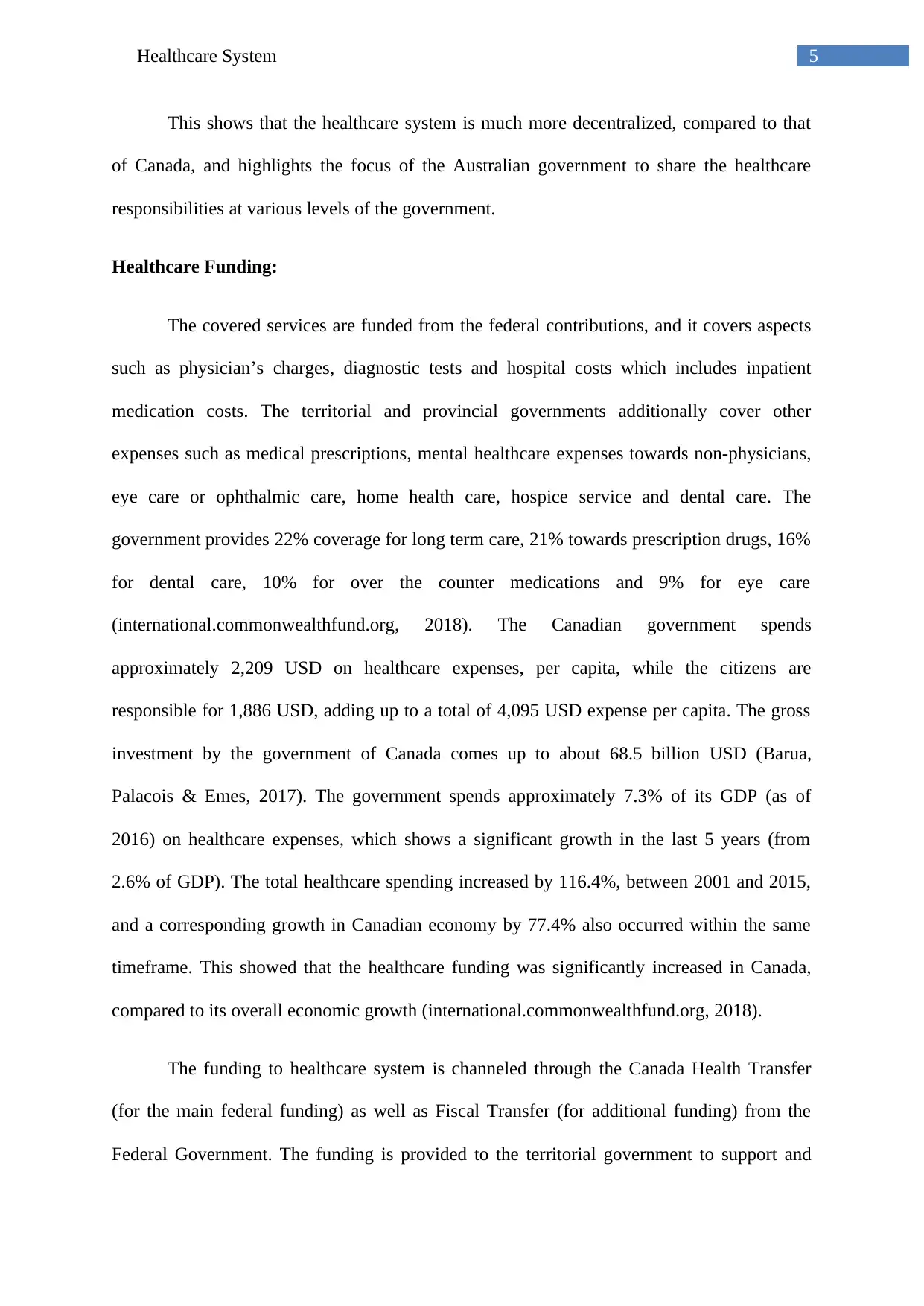
5Healthcare System
This shows that the healthcare system is much more decentralized, compared to that
of Canada, and highlights the focus of the Australian government to share the healthcare
responsibilities at various levels of the government.
Healthcare Funding:
The covered services are funded from the federal contributions, and it covers aspects
such as physician’s charges, diagnostic tests and hospital costs which includes inpatient
medication costs. The territorial and provincial governments additionally cover other
expenses such as medical prescriptions, mental healthcare expenses towards non-physicians,
eye care or ophthalmic care, home health care, hospice service and dental care. The
government provides 22% coverage for long term care, 21% towards prescription drugs, 16%
for dental care, 10% for over the counter medications and 9% for eye care
(international.commonwealthfund.org, 2018). The Canadian government spends
approximately 2,209 USD on healthcare expenses, per capita, while the citizens are
responsible for 1,886 USD, adding up to a total of 4,095 USD expense per capita. The gross
investment by the government of Canada comes up to about 68.5 billion USD (Barua,
Palacois & Emes, 2017). The government spends approximately 7.3% of its GDP (as of
2016) on healthcare expenses, which shows a significant growth in the last 5 years (from
2.6% of GDP). The total healthcare spending increased by 116.4%, between 2001 and 2015,
and a corresponding growth in Canadian economy by 77.4% also occurred within the same
timeframe. This showed that the healthcare funding was significantly increased in Canada,
compared to its overall economic growth (international.commonwealthfund.org, 2018).
The funding to healthcare system is channeled through the Canada Health Transfer
(for the main federal funding) as well as Fiscal Transfer (for additional funding) from the
Federal Government. The funding is provided to the territorial government to support and
This shows that the healthcare system is much more decentralized, compared to that
of Canada, and highlights the focus of the Australian government to share the healthcare
responsibilities at various levels of the government.
Healthcare Funding:
The covered services are funded from the federal contributions, and it covers aspects
such as physician’s charges, diagnostic tests and hospital costs which includes inpatient
medication costs. The territorial and provincial governments additionally cover other
expenses such as medical prescriptions, mental healthcare expenses towards non-physicians,
eye care or ophthalmic care, home health care, hospice service and dental care. The
government provides 22% coverage for long term care, 21% towards prescription drugs, 16%
for dental care, 10% for over the counter medications and 9% for eye care
(international.commonwealthfund.org, 2018). The Canadian government spends
approximately 2,209 USD on healthcare expenses, per capita, while the citizens are
responsible for 1,886 USD, adding up to a total of 4,095 USD expense per capita. The gross
investment by the government of Canada comes up to about 68.5 billion USD (Barua,
Palacois & Emes, 2017). The government spends approximately 7.3% of its GDP (as of
2016) on healthcare expenses, which shows a significant growth in the last 5 years (from
2.6% of GDP). The total healthcare spending increased by 116.4%, between 2001 and 2015,
and a corresponding growth in Canadian economy by 77.4% also occurred within the same
timeframe. This showed that the healthcare funding was significantly increased in Canada,
compared to its overall economic growth (international.commonwealthfund.org, 2018).
The funding to healthcare system is channeled through the Canada Health Transfer
(for the main federal funding) as well as Fiscal Transfer (for additional funding) from the
Federal Government. The funding is provided to the territorial government to support and
⊘ This is a preview!⊘
Do you want full access?
Subscribe today to unlock all pages.

Trusted by 1+ million students worldwide
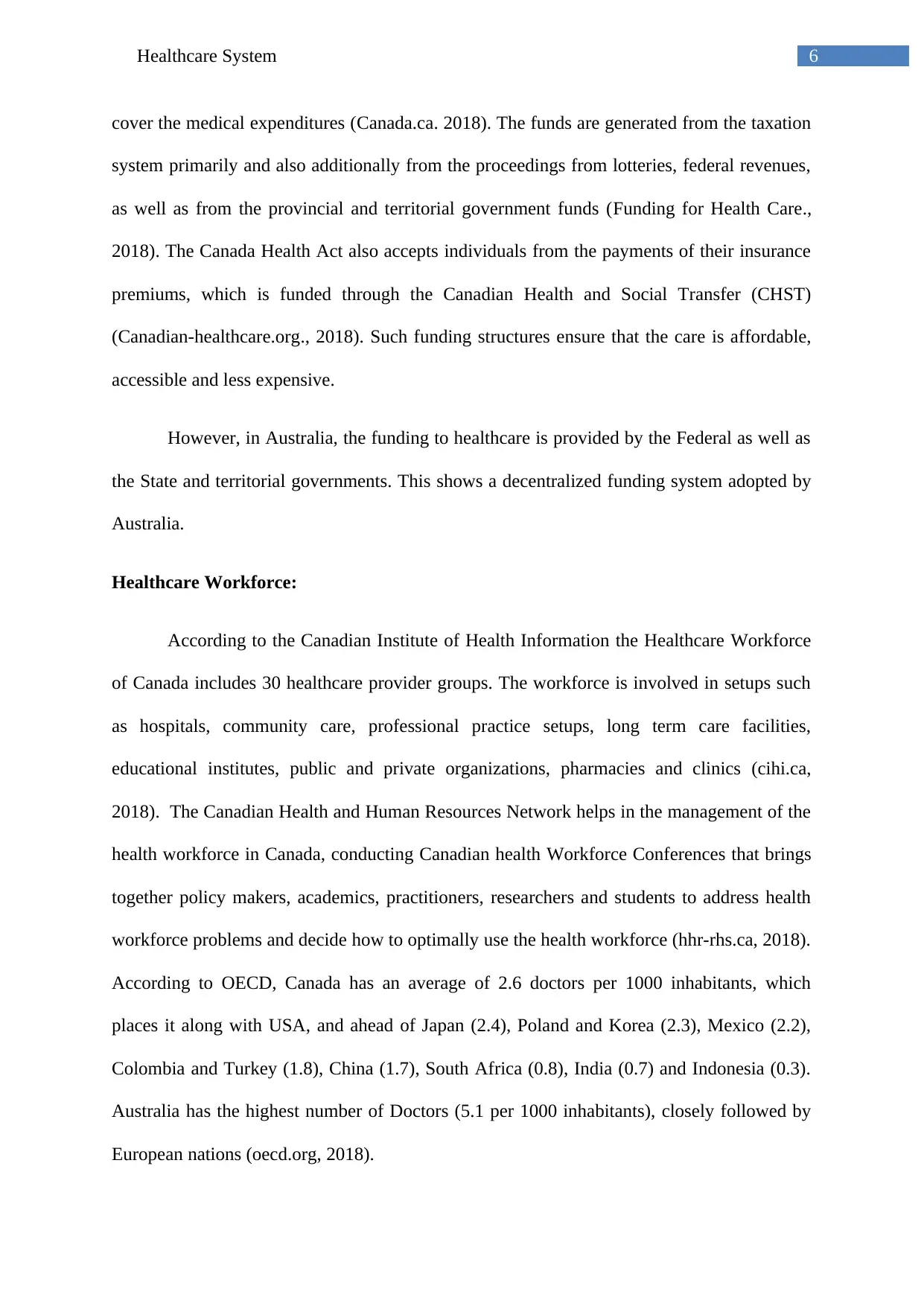
6Healthcare System
cover the medical expenditures (Canada.ca. 2018). The funds are generated from the taxation
system primarily and also additionally from the proceedings from lotteries, federal revenues,
as well as from the provincial and territorial government funds (Funding for Health Care.,
2018). The Canada Health Act also accepts individuals from the payments of their insurance
premiums, which is funded through the Canadian Health and Social Transfer (CHST)
(Canadian-healthcare.org., 2018). Such funding structures ensure that the care is affordable,
accessible and less expensive.
However, in Australia, the funding to healthcare is provided by the Federal as well as
the State and territorial governments. This shows a decentralized funding system adopted by
Australia.
Healthcare Workforce:
According to the Canadian Institute of Health Information the Healthcare Workforce
of Canada includes 30 healthcare provider groups. The workforce is involved in setups such
as hospitals, community care, professional practice setups, long term care facilities,
educational institutes, public and private organizations, pharmacies and clinics (cihi.ca,
2018). The Canadian Health and Human Resources Network helps in the management of the
health workforce in Canada, conducting Canadian health Workforce Conferences that brings
together policy makers, academics, practitioners, researchers and students to address health
workforce problems and decide how to optimally use the health workforce (hhr-rhs.ca, 2018).
According to OECD, Canada has an average of 2.6 doctors per 1000 inhabitants, which
places it along with USA, and ahead of Japan (2.4), Poland and Korea (2.3), Mexico (2.2),
Colombia and Turkey (1.8), China (1.7), South Africa (0.8), India (0.7) and Indonesia (0.3).
Australia has the highest number of Doctors (5.1 per 1000 inhabitants), closely followed by
European nations (oecd.org, 2018).
cover the medical expenditures (Canada.ca. 2018). The funds are generated from the taxation
system primarily and also additionally from the proceedings from lotteries, federal revenues,
as well as from the provincial and territorial government funds (Funding for Health Care.,
2018). The Canada Health Act also accepts individuals from the payments of their insurance
premiums, which is funded through the Canadian Health and Social Transfer (CHST)
(Canadian-healthcare.org., 2018). Such funding structures ensure that the care is affordable,
accessible and less expensive.
However, in Australia, the funding to healthcare is provided by the Federal as well as
the State and territorial governments. This shows a decentralized funding system adopted by
Australia.
Healthcare Workforce:
According to the Canadian Institute of Health Information the Healthcare Workforce
of Canada includes 30 healthcare provider groups. The workforce is involved in setups such
as hospitals, community care, professional practice setups, long term care facilities,
educational institutes, public and private organizations, pharmacies and clinics (cihi.ca,
2018). The Canadian Health and Human Resources Network helps in the management of the
health workforce in Canada, conducting Canadian health Workforce Conferences that brings
together policy makers, academics, practitioners, researchers and students to address health
workforce problems and decide how to optimally use the health workforce (hhr-rhs.ca, 2018).
According to OECD, Canada has an average of 2.6 doctors per 1000 inhabitants, which
places it along with USA, and ahead of Japan (2.4), Poland and Korea (2.3), Mexico (2.2),
Colombia and Turkey (1.8), China (1.7), South Africa (0.8), India (0.7) and Indonesia (0.3).
Australia has the highest number of Doctors (5.1 per 1000 inhabitants), closely followed by
European nations (oecd.org, 2018).
Paraphrase This Document
Need a fresh take? Get an instant paraphrase of this document with our AI Paraphraser
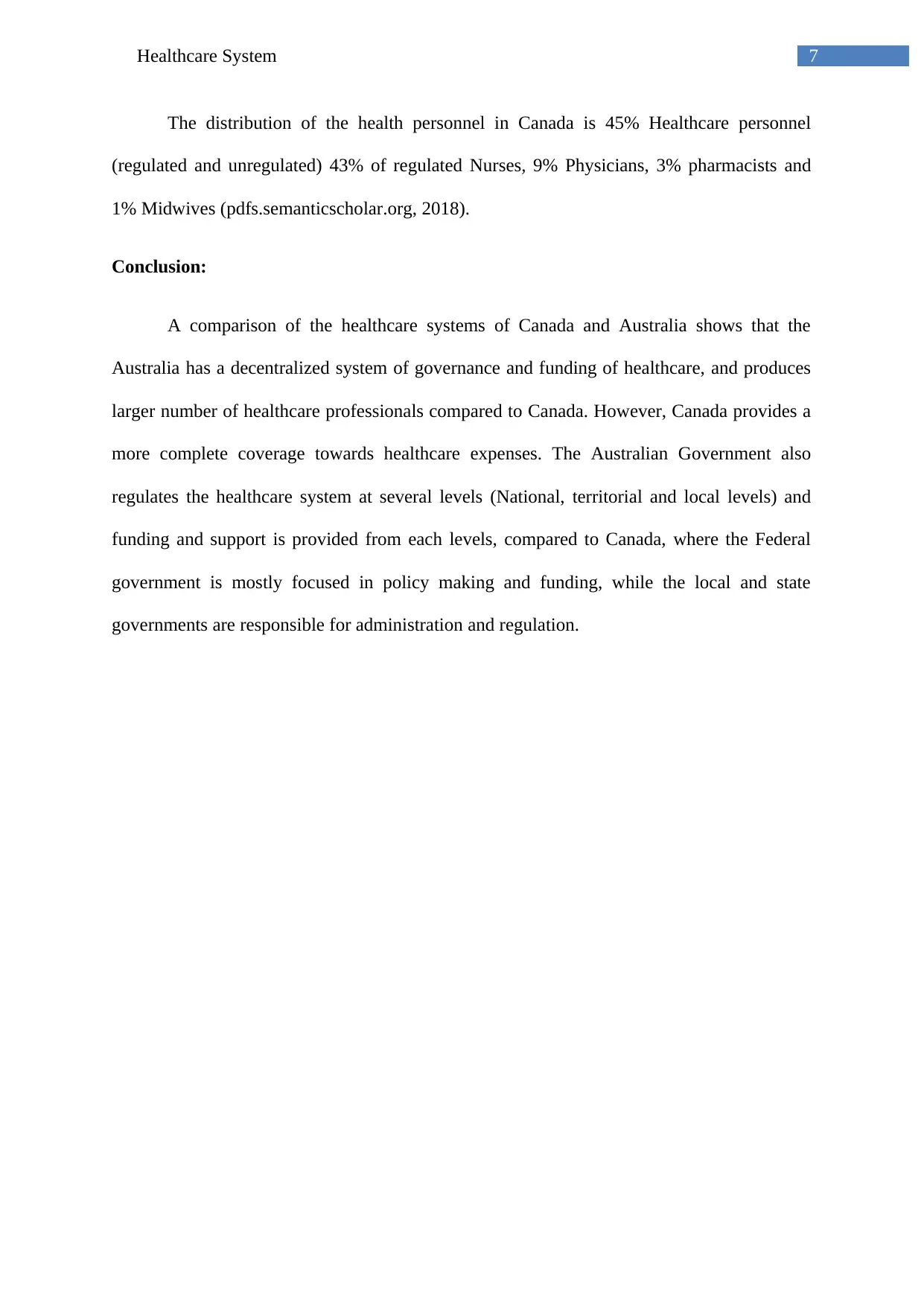
7Healthcare System
The distribution of the health personnel in Canada is 45% Healthcare personnel
(regulated and unregulated) 43% of regulated Nurses, 9% Physicians, 3% pharmacists and
1% Midwives (pdfs.semanticscholar.org, 2018).
Conclusion:
A comparison of the healthcare systems of Canada and Australia shows that the
Australia has a decentralized system of governance and funding of healthcare, and produces
larger number of healthcare professionals compared to Canada. However, Canada provides a
more complete coverage towards healthcare expenses. The Australian Government also
regulates the healthcare system at several levels (National, territorial and local levels) and
funding and support is provided from each levels, compared to Canada, where the Federal
government is mostly focused in policy making and funding, while the local and state
governments are responsible for administration and regulation.
The distribution of the health personnel in Canada is 45% Healthcare personnel
(regulated and unregulated) 43% of regulated Nurses, 9% Physicians, 3% pharmacists and
1% Midwives (pdfs.semanticscholar.org, 2018).
Conclusion:
A comparison of the healthcare systems of Canada and Australia shows that the
Australia has a decentralized system of governance and funding of healthcare, and produces
larger number of healthcare professionals compared to Canada. However, Canada provides a
more complete coverage towards healthcare expenses. The Australian Government also
regulates the healthcare system at several levels (National, territorial and local levels) and
funding and support is provided from each levels, compared to Canada, where the Federal
government is mostly focused in policy making and funding, while the local and state
governments are responsible for administration and regulation.

8Healthcare System
References:
aihw.gov.au (2018), Australia’s Health System, retrieved on 31 May, 2018, from:
https://www.aihw.gov.au/getmedia/f2ae1191-bbf2-47b6-a9d4-1b2ca65553a1/ah16-2-
1-how-does-australias-health-system-work.pdf.aspx
Barua, B., Palacois, M., & Emes, J. (2017). The Sustainability of Health Care Spending in
Canada 2017. Fraserinstitute.org. Retrieved 14 January 2018, from
https://www.fraserinstitute.org/sites/default/files/sustainability-of-health-care-
spending-in-canada-2017.pdf
Braithwaite, J., Hibbert, P., Blakely, B., Plumb, J., Hannaford, N., Long, J. C., & Marks, D.
(2017). Health system frameworks and performance indicators in eight countries: A
comparative international analysis. SAGE open medicine, 5, 2050312116686516.
canada.ca (2018), Healthcare System, retrieved on 31 May 2018, from:
https://www.canada.ca/en/health-canada/services/health-care-system/reports-
publications/health-care-system/canada.html
canada.ca (2018), Healthcare Systems, retrieved on 31 May, 2018. From:
https://www.canada.ca/en/health-canada/services/health-care-system/reports-
publications/health-care-system/canada.html
canadian-healthcare.org (2018), Canadian Healthcare, retrieved on 31 May, 2018. From:
http://www.canadian-healthcare.org/
cihi.ca (2018), Health Workforce Database 2016, RRetrieved on 31 May, 2018, from:
https://www.cihi.ca/sites/default/files/document/hwdb-meth-guide-2017-en-web.pdf
References:
aihw.gov.au (2018), Australia’s Health System, retrieved on 31 May, 2018, from:
https://www.aihw.gov.au/getmedia/f2ae1191-bbf2-47b6-a9d4-1b2ca65553a1/ah16-2-
1-how-does-australias-health-system-work.pdf.aspx
Barua, B., Palacois, M., & Emes, J. (2017). The Sustainability of Health Care Spending in
Canada 2017. Fraserinstitute.org. Retrieved 14 January 2018, from
https://www.fraserinstitute.org/sites/default/files/sustainability-of-health-care-
spending-in-canada-2017.pdf
Braithwaite, J., Hibbert, P., Blakely, B., Plumb, J., Hannaford, N., Long, J. C., & Marks, D.
(2017). Health system frameworks and performance indicators in eight countries: A
comparative international analysis. SAGE open medicine, 5, 2050312116686516.
canada.ca (2018), Healthcare System, retrieved on 31 May 2018, from:
https://www.canada.ca/en/health-canada/services/health-care-system/reports-
publications/health-care-system/canada.html
canada.ca (2018), Healthcare Systems, retrieved on 31 May, 2018. From:
https://www.canada.ca/en/health-canada/services/health-care-system/reports-
publications/health-care-system/canada.html
canadian-healthcare.org (2018), Canadian Healthcare, retrieved on 31 May, 2018. From:
http://www.canadian-healthcare.org/
cihi.ca (2018), Health Workforce Database 2016, RRetrieved on 31 May, 2018, from:
https://www.cihi.ca/sites/default/files/document/hwdb-meth-guide-2017-en-web.pdf
⊘ This is a preview!⊘
Do you want full access?
Subscribe today to unlock all pages.

Trusted by 1+ million students worldwide
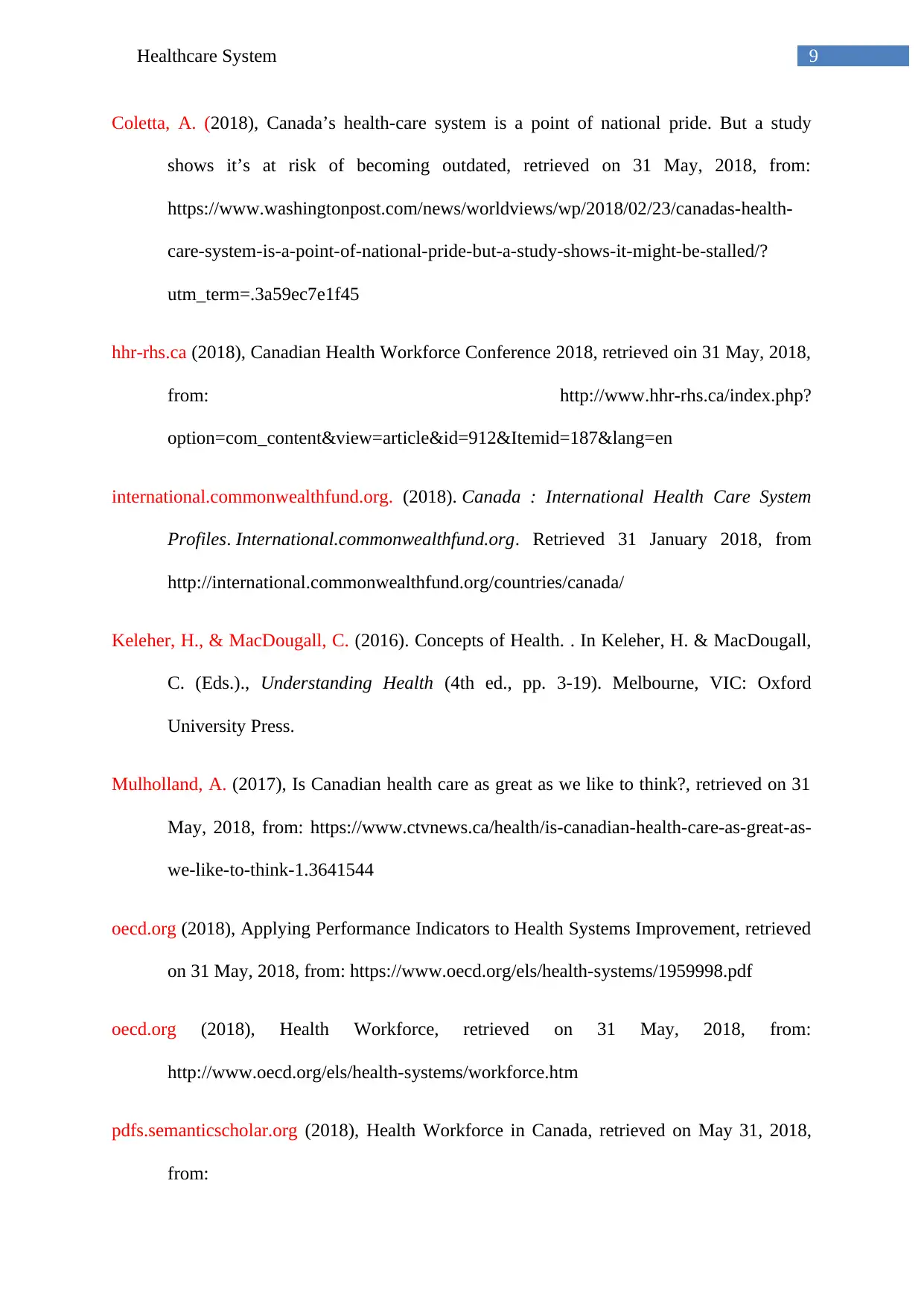
9Healthcare System
Coletta, A. (2018), Canada’s health-care system is a point of national pride. But a study
shows it’s at risk of becoming outdated, retrieved on 31 May, 2018, from:
https://www.washingtonpost.com/news/worldviews/wp/2018/02/23/canadas-health-
care-system-is-a-point-of-national-pride-but-a-study-shows-it-might-be-stalled/?
utm_term=.3a59ec7e1f45
hhr-rhs.ca (2018), Canadian Health Workforce Conference 2018, retrieved oin 31 May, 2018,
from: http://www.hhr-rhs.ca/index.php?
option=com_content&view=article&id=912&Itemid=187&lang=en
international.commonwealthfund.org. (2018). Canada : International Health Care System
Profiles. International.commonwealthfund.org. Retrieved 31 January 2018, from
http://international.commonwealthfund.org/countries/canada/
Keleher, H., & MacDougall, C. (2016). Concepts of Health. . In Keleher, H. & MacDougall,
C. (Eds.)., Understanding Health (4th ed., pp. 3-19). Melbourne, VIC: Oxford
University Press.
Mulholland, A. (2017), Is Canadian health care as great as we like to think?, retrieved on 31
May, 2018, from: https://www.ctvnews.ca/health/is-canadian-health-care-as-great-as-
we-like-to-think-1.3641544
oecd.org (2018), Applying Performance Indicators to Health Systems Improvement, retrieved
on 31 May, 2018, from: https://www.oecd.org/els/health-systems/1959998.pdf
oecd.org (2018), Health Workforce, retrieved on 31 May, 2018, from:
http://www.oecd.org/els/health-systems/workforce.htm
pdfs.semanticscholar.org (2018), Health Workforce in Canada, retrieved on May 31, 2018,
from:
Coletta, A. (2018), Canada’s health-care system is a point of national pride. But a study
shows it’s at risk of becoming outdated, retrieved on 31 May, 2018, from:
https://www.washingtonpost.com/news/worldviews/wp/2018/02/23/canadas-health-
care-system-is-a-point-of-national-pride-but-a-study-shows-it-might-be-stalled/?
utm_term=.3a59ec7e1f45
hhr-rhs.ca (2018), Canadian Health Workforce Conference 2018, retrieved oin 31 May, 2018,
from: http://www.hhr-rhs.ca/index.php?
option=com_content&view=article&id=912&Itemid=187&lang=en
international.commonwealthfund.org. (2018). Canada : International Health Care System
Profiles. International.commonwealthfund.org. Retrieved 31 January 2018, from
http://international.commonwealthfund.org/countries/canada/
Keleher, H., & MacDougall, C. (2016). Concepts of Health. . In Keleher, H. & MacDougall,
C. (Eds.)., Understanding Health (4th ed., pp. 3-19). Melbourne, VIC: Oxford
University Press.
Mulholland, A. (2017), Is Canadian health care as great as we like to think?, retrieved on 31
May, 2018, from: https://www.ctvnews.ca/health/is-canadian-health-care-as-great-as-
we-like-to-think-1.3641544
oecd.org (2018), Applying Performance Indicators to Health Systems Improvement, retrieved
on 31 May, 2018, from: https://www.oecd.org/els/health-systems/1959998.pdf
oecd.org (2018), Health Workforce, retrieved on 31 May, 2018, from:
http://www.oecd.org/els/health-systems/workforce.htm
pdfs.semanticscholar.org (2018), Health Workforce in Canada, retrieved on May 31, 2018,
from:
Paraphrase This Document
Need a fresh take? Get an instant paraphrase of this document with our AI Paraphraser

10Healthcare System
https://pdfs.semanticscholar.org/presentation/3f66/366b65dee09633470c27ff547924f
182d102.pdf
https://pdfs.semanticscholar.org/presentation/3f66/366b65dee09633470c27ff547924f
182d102.pdf
1 out of 11
Related Documents
Your All-in-One AI-Powered Toolkit for Academic Success.
+13062052269
info@desklib.com
Available 24*7 on WhatsApp / Email
![[object Object]](/_next/static/media/star-bottom.7253800d.svg)
Unlock your academic potential
Copyright © 2020–2025 A2Z Services. All Rights Reserved. Developed and managed by ZUCOL.





